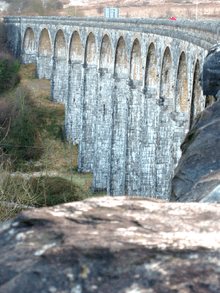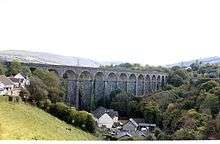Cefn-coed-y-cymmer


Cefn-coed-y-cymmer (also Cefn coed y cymer, Cefn Coed y Cymer, Cefn Coed-y-cymmer and Cefncoedycymer) (pronounced [ˌkɛvɛnˌkɔɨ̯dəˈkəmɛr]) is a small community on the northwestern edge of Merthyr Tydfil County Borough in south Wales. It is situated in the neck of land between the rivers Taf Fawr and Taf Fechan at their confluence (Welsh: 'cymer'). The village lies within the community of Vaynor. Immediately to the north of the village is the hill of Cefn Cil Sanws on the southern slopes of which is Merthyr Tydfil Golf Club. The village is bounded both to the north and the west by the Brecon Beacons National Park.[1]

Notable features of the village are the A465 Heads of the Valleys Road and the impressive curving Cefn Coed Viaduct. The viaduct, which spans the Taf Fawr river, came into being as part of the Merthyr- Pontsticill junction line. This additional line extended the Brecon and Merthyr Railway and was only agreed following a special Act of Parliament in July 1862 to allow its construction.[2]

The viaduct is the third largest in Wales and is now a Grade II listed building. It was designed by Alexander Sutherland in conjunction with Henry Conybeare and partly built by Thomas Savin and John Ward. In early 1866, the project faced disaster when Savin and Ward suffered serious financial and legal difficulties. It was eventually completed with the assistance of Alexander Sutherland. He produced an alternative route into Merthyr, curving the viaduct, so that the railway line avoided property owned by ironmaster Robert Thompson Crawshay.[3] It cost £25,000 to build (equivalent to £2.1 million in 2015).[4]
It consists of 15 arches, each one 39 feet 6 inches wide, and is 770 ft. long with a maximum height of 115 ft. It was planned to be constructed entirely of limestone like the nearby Pontsarn Viaduct but a trade union strike by stonemasons in February 1866 caused the company to buy 800,000 bricks and use bricklayers to complete the 15 arches.[5] It was completed on 29 October 1866, three years after the main line which linked it with Brecon.[6] The last trains travelled over the viaduct in the mid 1960s and it subsequently fell into disrepair. It was refurbished by Merthyr Tydfil County Borough Council with assistance from a grant from the National Lottery. It has now become part of the Taff Trail, route 8 of the National Cycleway.[7]
Jewish Cemetery
Beyond the last buildings of Cefn, parallel to the A470 Merthyr to Brecon road, lies another site of historical interest. This is the Jewish cemetery, one of the largest in Wales outside Cardiff. It was established and consecrated in the 1860s by the then thriving Merthyr Hebrew Congregation. The growth of the Jewish population in the area was mainly linked to the expansion of the mining and ironworks industry in the locality. Many were refugees from Russia, Poland and Romania, fleeing religious persecution.[8] The cost of the land for the cemetery was mainly paid for by the local community, but contributions were also made by Jewish communities and individuals across Britain, the largest amount being £10 from the politician and philanthropist, Baron Lionel de Rothschild. Initially the cemetery was simply a burial ground, with no building on the site. In the late 1890s a simple brick built prayer house (ohel) was constructed, again using funds raised by the local Jewish community.[9] In 1935, the cemetery was extended, with the new section being formally consecrated in October 1935.[10] A map of the cemetery is held in the archives at Merthyr Tydfil Central Library.The map shows the location of approximately 570 graves, and gives the names and dates of death of many of the deceased.[11] Towards the end of the twentieth century, the Jewish population declined. The community has now left the Merthyr area and responsibility for maintenance of the cemetery has been transferred to the Local Authority.[12]
-

Prayer house
-

Interior of prayer house
-

Headstones - Jewish Cemetery, Merthyr
References
- ↑ Ordnance Survey 1:25,000 scale Explorer map sheet OL12 Brecon Beacons National Park: western area
- ↑ Welsh Railways Research Circle. Brecon & Merthyr Tydfil Junction Railway. (http://www.wrrc.org.uk/b&mrc.php) Retrieved 25 January 2016
- ↑ 'Cefn Viaduct. It's a lesson in the mason's art.' (10 August 1973) Merthyr, Tredegar and Abergavenny Railway and branches by W.W. Tasker (Poole: Oxford Publishing Company,1986), p.139.
- ↑ UK CPI inflation numbers based on data available from Gregory Clark (2016), "The Annual RPI and Average Earnings for Britain, 1209 to Present (New Series)" MeasuringWorth.
- ↑ Merthyr Tydfil Heritage Regeneration Trust. Heritage Plaques (Places): Cefn-Coed or Pontycapel Viaduct. (http://www.mtht.co.uk/Buildings.html) Retrieved 25 January 2016
- ↑ 'The Brecon County Times Neath Gazette' and General Advertiser for the Counties of Brecon, Carmarthen, Radnor, Monmouth, Glamorgan, Cardigan, Montgomery, Hereford. 3rd November 1866. (http://newspapers.library.wales/view/3856058/56/viaduct%20AND%20cefn) Retrieved 18 January 2016
- ↑ The Taff Trail: Cefn Coed Viaduct (http://www.tafftrail.org.uk) Retrieved 18 January 2016
- ↑ 'The Valleys Communities' in the Jews of South Wales: Historical Studies, ed. by Ursula R.Q. Henriques, (Cardiff: University of Wales Press,1993) pp. 45-67
- ↑ 'Merthyr Landmarks'; Merthyr Express, 29 March 1974. Courtesy of Merthyr Tydfil Central Library.
- ↑ 'Merthyr Hebrews. Consecration of New Cemetery at Cefn.' Merthyr Express, 2 November 1935, Courtesy of Merthyr Tydfil Central Library.
- ↑ Map of Jewish Cemetery (dated after 1999): North, South and Central sections. Courtesy of Merthyr Tydfil Central Library.
- ↑ Merthyr Tydfil County Borough Council (http://www.merthyr.gov.uk/residents/births-deaths-marriages/family-history-search/) Retrieved 18 January 2016